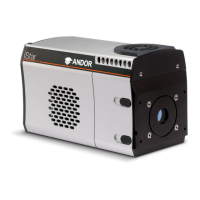Appendix
Cou
ts
Counts refer to the digitization by the A/D conversion and are the basic unit in which data are displayed and processed.
Depending on the particular version of the detection device, one count may, for example, be equated with a charge of 10
photoelectrons on a pixel of the CCD.
DARK SIGNAL
Dark signal, a charge usually expressed as a number of electrons, is produced by the ow of dark current during the
exposure time. All CCD produce a dark current, an actual current that is measurable in (typically tenths of) milliamps
per pixel. The dark signal adds to your measured signal level, and increases the amount of noise in the measured signal.
Since the dark signal varies with temperature, it can cause background values to increase over time. It also sets a limit
on the useful exposure time.
Reducing the temperature of the CCD reduces dark signal (typically, for every 7ºC that temperature falls, dark signal
halves). CCD readout noise is low, and so as not to compromise this by shot noise from the dark signal, it is important
to cool the detector to reduce the dark signal. If you are using an exposure time of less than a few seconds, cooling the
detector below 0ºC will generally remove most of the shot noise caused by dark signal.
DETECTION LIMIT
The Detection Limit is a measure of the smallest signal that can be detected in a single readout. The smallest signal is
dened as the signal whose level is equal to the noise accompanying that signal, i.e. a signal to noise ratio (S/N) of
unity.
Sources of noise are:
• Shotnoiseofthesignalitself
• Shotnoiseofanydarksignal
• Readoutnoise
If the signal is small, we can ignore its shot noise.
EXPOSURE TIME
The Exposure Time is the period during which the CCD collects light prior to readout. In the Andor system it is marked
by a pulse on the Fire output (Pin 11) of the Controller Card’s auxiliary connector
KEEP CLEANS
The CCD-sensor is continually being scanned to keep it in a “ready state”. Scanning involves moving charge from
the CCD-sensor into the shift register and then emptying the shift register. If the scan is being used simply to clean the
CCD-sensor (i.e. it is a keep-clean scan), the charge that is emptied from the shift register is not stored in memory and
is, in effect, discarded.
While running an Accumulate or Kinetic acquisition, use the Keep Clean Dialogue box to enter a minimum number of
Keep Cleans between each scan in the series.
COUNTS

